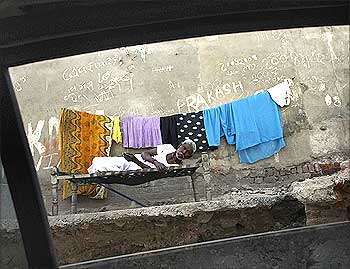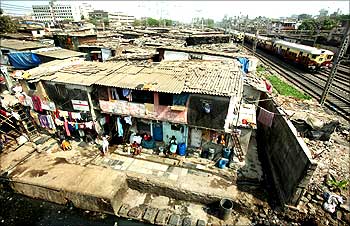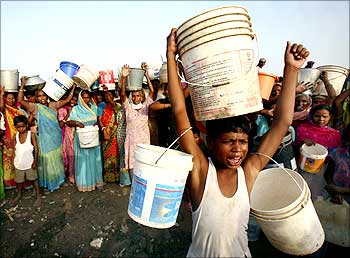Photographs: Parth Sanyal/Reuters Lalit K Jha in Washington
Unlike the general impression, slums in major Indian cities not only represent complex political and social issues, but also generate a lot of local economic activities, a latest research by the prestigious Stanford Graduate School of Business has said.
"Indian slums are incredibly productive," said Saumitra Jha, assistant professor of Political Economy at the Stanford Graduate School of Business.
Indian slums or economic hubs?
Image: A boy eats roti at a slum in Mumbai.Photographs: Arko Datta/Reuters
The project was funded by the World Bank's Research Department. His work with the World Bank's Vijayendra Rao and Michael Woolcock surveyed 802 households from 30 slums in Delhi.
Mumbai, where much of 'Slumdog' takes place, includes the Dharavi slum, one of the largest leather producers in the world. "People are becoming much more aware that slums are where a lot of the economic activity is taking place," Jha said.
"It's not just poor people who live there," he said.Indian slums or economic hubs?
Image: High rise buildings are seen behind a slum in Mumbai.Photographs: Arko Datta/Reuters
Some more financially sound residents prefer living in the slums because they are inexpensive and closer to their workplaces. "It's remarkable how wide the discrepancy in wealth is."
One area of Delhi, the report describes, as a 'five-star slum,' has running water, electricity and other amenities.
"The only reason it is a slum was because it is an illegal settlement. They just don't own the property," he said.
Indian slums or economic hubs?
Image: A man sleeps beside the street at a slum in Ahmedabad.Photographs: Arko Datta/Reuters
Older, more established slums, where residents have formed cohesive communities such as Dariba Kalan in Delhi, have erupted into riots in the face of government efforts to tear them down, even when the government has offered to resettle the displaced people, the press statement said.
During his research, Jha found that how the slums are run depends on a variety of factors, such as their ethnic makeup, political connections, and how long they have been established.
Indian slums or economic hubs?
Image: A general view of Mumbai's Dharavi, considered Asia's biggest slum.Photographs: Punit Paranjpe/Reuters
Newer slums often have it particularly tough, he said, because they might have neither the political clout to avoid being torn down by the government nor the infrastructure to help protect residents from fire and the theft of personal items. They also may lack the internal leadership to fend off these threats, the report said.
Key to running many slums, however, are pradhans, the areas' informal leaders, who often can call on political influence to help their neighbourhoods. The study described one unnamed slum run by a former domestic servant of a mainstream political party's leader.
Indian slums or economic hubs?
Image: Slum dwellers shout slogans as they carry empty containers during a protest in Chandigarh.Photographs: Ajay Verma/Reuters
"She basically ran the show for 20 years," Jha said. But that all changed when a rival party gained power. "Her political connections were with the wrong party."
Some new slums, occupied by a single major ethnic group, can gain political clout because they are more likely to follow one set of leaders, who can then promise politicians clusters of votes. "When leadership is less clear, that can be really detrimental," he said.







article